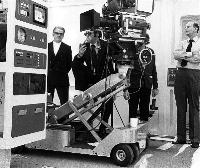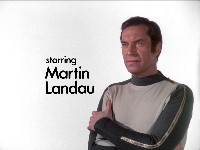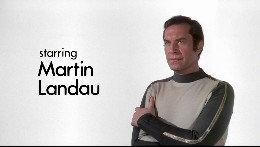Film
by Martin Willey
Space: 1999 was filmed on 35mm film. Other TV series were shot on 16mm film (half the size and thus lower quality) or videotape, but the production company ITC marketed the series internationally and 35mm was the highest quality and most portable format.

Space 1999 was filmed with 35mm Mitchell cameras. The model was first introduced in 1932 and was the industry standard until the 1980s, when more lightweight 35mm cameras such as Panavision's Panaflex became popular, and later, as digital cameras began to replace film. Here it is mounted on a camera dolly, a large stable trolley which carries the camera on a hydraulic arm, allowing the camera to move with a very smooth stable motion while filming. The lens is a Cooke Optics lens.

Camera operator Neil Binney and director Lee Katzin film a scene in Medical for Breakaway. The camera is marked "Pinewood Studios XR 309" (the camera equipment and studio space were rented from Pinewood). The camera is mounted on a Moy geared head, a cradle with mechanical gears which enable the camera to be tilted and panned. The rails around the lens are part of the follow focus mechanism, allowing an operator (the "focus puller") to change the lens focus during the shot.

Camera operator Neil Binney filming Earthbound. The 3-phase sync A/C motor powers the camera. The text "BNCR" on the film magazine stands for "Blimped News Camera Reflex", the lens mount used on Mitchell cameras. As the name suggests, it was developed originally for newsreel cameras and adapted for movie production with a soundproof camera case called the blimp housing. The BNCR was introduced in 1967 with a mirror system, the reflex, which allowed the operator to see the picture being filmed.
The director of photography ("lighting cameraman" in Year 2) is responsible for lighting the set and determines the lens; this was Frank Watts BSC or Brendan Stafford. The camera operators were Neil Binney and Tony White. As the camera moved, or the cast moved in front of the camera, the focus puller (also "assistant cameraman") ensures the lens is correctly focussed; this was Mike Tomlin.
The standard frame rate for film is 24 frames per second. With 16 frames per foot of film, 90 feet (27 metres) of film represents 1 minute.
Although this speed is used in cinemas, television in the 1970s used one of two slightly different speeds: 25 frames per second in the UK and Europe, or 29.97 frames per second in North America. On UK and European TV systems (PAL and SECAM) film was slightly speeded up to 25 frames per second (a 4% speed-up, just detectable in audio). On North American systems, the NTSC system requires 29.97 frames per second, so the film was converted to using a technique called 3:2 pulldown (showing every third frame twice). This can be visible as a stutter in slow camera movements.
Space 1999 may have been filmed at the standard rate of 24 frames per second (special effects shots were filmed at higher ratios of this). However, there is some evidence it was filmed at 25 frames a second.
Many sets include video monitors- in communications posts and Eagle consoles, for instance, which would use the UK standard 50hz frequency, showing 25 interlaced frames per second. As a 24 fps camera and 25 fps monitors have a different frequency, a strobing effect is visible on the monitor. One solution to this is to film at 25 frames per second.
Some original audio tapes recorded on the studio floor exist with labels indicating a camera speed of 25fps. Music, sound effects and post-production dubbing was done at 24 frames per second. For the 2004 remastering, Jonathan Wood used 25 fps.
The SFX studio at Bray also used a high speed 35mm Mitchell camera for model photography. Shots involving motion were filmed at high speed- 48 or 96 frames per second - in order to ensure steady movement.
Large explosions were filmed with a special high speed camera, a 16mm Photo-Sonics, which could run at 1000 frames per second. On one shot the camera assistant mis-dialled it at 10,000 frames per second, which used up the film reel in 1.5 seconds. They only discovered the shot worked when they saw the daily print the following day.
The original film negative, shot in the studio cameras, was printed overnight onto positive film. The crew would watch the film "rushes" the following morning. If there were problems, the scene could be immediately re-filmed. The original negative is stored safely. The editors create a workprint, physically cutting the film and gluing it in the correct order. This is positive film, and can be projected for the director and producers. At the same time, the audio is rough-cut to the print. Audio was recorded separately (the clapperboard sound synchronises the start of each scene). At this time, problems with the story, shots or audio may become evident, which may prompt re-shooting. More commonly, the studio sound may be imperfect, so the actors will be called to re-record the dialogue, to match the workprint scenes.
When the workprint is completed and approved, the original negative is cut. The negative cutter matches the workprint shots to the negative. Meanwhile, the final audio is created, with sound effects and music. The cut negative is made into an answer print which is colour corrected. When approved, a interpositive ("interpos") print is made, a positive image printed on fine grained negative stock. This is the master source of the episode. An internegative ("interneg") is then made from the interpos, which is a negative image. Duplicate films are then made from the interneg.
35mm and 16mm duplicate films were made and distributed to broadcasters. Each broadcaster would repair film damage and sometimes make editorial cuts, and the cut and damaged versions would then be passed on to the next company to broadcast the episode. The films were "combined optical film", with the optical sound signal printed in a strip by the side of the picture. To show the episode, the television company would play the film in a telecine machine, which converted the film image and sound into a television signal (PAL or SECAM in Europe, NTSC in the USA). From the 1980s onwards, ITC used a telecine to create 1 inch videotape, which was sent to television companies instead of film.
In the UK original 1970s broadcasts, there were two 35mm films per episode. In the US and other countries, mostly 16mm prints were used, but some 35mm prints were made, including The Metamorph (the early cut with the orange tree), and Journey To Where.
The episodes were broadcast in the US in NTSC (525 scanlines, of which 486 are visible, at 29.97 frames per second), and in Europe in PAL (625 lines, of which 576 visible, at 25 frames per second). It should be noted that televisions of the mid-1970s were much smaller and technically inferior to modern TVs- a 19inch screen was large, and black and white represented a large proportion of sets. In the UK and most countries outside the US, most viewers watched in black and white.
Space: 1999 was filmed in 4:3 ratio (the full 35mm frame, the same proportions of domestic televisions). A 16:9 "widescreen" ratio version was created in 2004, cropping the top and bottom of the picture (see below).
For the 1982 UK repeats, new 16mm film prints were made, although four episodes were 35mm film prints from the original 1975-6 run.
In the 1980s, four compilation movies were made. All four movies were printed to 35mm film prints. The second two compilation movies were edited on videotape before being printed on 35-mm film. These were then converted by telecine to videotape, which is the source of all videotape releases since. The first two movies had PAL videotapes for the UK market. The second two movies only had the US NTSC standard videotape, which had to be further converted to the PAL standard for UK release, causing obvious degradation in image and sound.
In 1980, VHS videotape became popular and the compilation movies were released on tape in the UK and later in the US. In 1991 (US)/ 1992 (UK) individual episodes were first released. These tapes were derived from existing 1 inch videotape, based on 16mm prints. However, two episodes, Breakaway and War Games, were based on 35-mm prints.
Two episodes, Dragon's Domain and The Testament Of Arkadia, had sound problems, and were reissued.
In 1992 in the US, a set of laserdiscs of the episodes were created based on 35mm interpositives stored in Los Angeles. The video masters created for this set were used in subsequent DVD releases. The sound came from 16-mm mag tracks, dubs from the original 35mm mag tracks. The telecine transfers were not very good, often overly dark, with varying colour correction and sharpness even within scenes, and a few small cuts.
These transfers were used by Carlton for their 2001 video release, and by the BBC for their 1998 broadcasts. The BBC made edited copies on a digital tape format called D3, which removed the fade for commercial breaks.
Again, Dragon's Domain and The Testament Of Arkadia had problems (colour and sound), while some year 2 episodes were dark. The US DVDs improved some year 2 episodes, although sometimes with more grain. They also did a "bonus disk" with better versions of Dragon's Domain and The Testament Of Arkadia.
In 2004, new film masters of Year One were made. The original film elements were cleaned, removing dirt and restoring damage and deterioration. Many of the original film "masters" - the interneg prints- had deteriorated over time. In these cases, the original negatives (the edited film from the studio cameras) or interpos prints (the original colour corrected print) are used to create new "protection elements" - so called internegs - from which new film prints (or digital prints) can be made.
The second stage is to create a digital version. A machine called a telecine scans the film into a digital signal. The digital version is then edited, using computer techniques to clean further dirt, bad splices and damage, and to adjust the colours ("colour grading"). This digital master is used to create standard definition (for DVD and broadcast) and high definition (for HD TV and Blu-Ray DVD).
Two different high definition masters were created- one using the original 4:3 image ratio, the other at the 16:9 widescreen format favoured by HD broadcasters. Standard definition TV has an approximate pixel resolution of 720×480 (note that TV has rectangular pixels, so to view on computer the ratio must be altered again). High definition TV images have a pixel resolution of 1280×720 or 1920×1080 (Space 1999 was mastered in the latter). It has thus approximately twice the image information, although as lossy compression is applied there may be compression flaws visible.
 |
 |
These masters were created by Jonathan Wood of BBC Resources, and initiated and paid for by the DVD company Network for their UK release on Blu-ray in 2005. The 16:9 high definition masters were first broadcast in trials by the channel ITV-HD in 2006.
In 2007 the same restoration was performed for The Metamorph, the first episode of Year 2. New interpositive masters were prepared by ITV.
In 2014-2015, Network Distributing with ITV commissioned the remastering of the remainder of Year 2 from BBC Post Production and Studios (formerly BBC Resources). The colourist was Jonathan Wood with picture restoration by Amanda Whitby. The HD episodes were released on Blu-ray in September 2015. According to the notes: "The 35mm original negatives were transferred in High Definition on a Spirit Datacine, before undergoing complete restoration. The image was scene-to-scene colour graded and extensively grain-managed with thousands of instances of dirt and defects being removed via automated and manual processes. Other major faults corrected included warping, movement (jitter) and flicker."
In the original broadcasts, two episodes had an alternative version, seen in only a few stations. Both were probably early preview copies that remained in circulation.
The remastered HD versions of the episodes have some small differences to the versions originally seen in 1975.
When the HD remastering was done, the title sequences and all in-episodes text were remade using text-less versions of the film (kept for non-English versions) with new text added digitally. Although they kept the two different Barry Morse credits, two episodes originally had different "This Episode"/"September"/"1999" captions. In most episodes, and all of the HD versions, it is yellow text on blue background. In Breakaway and End Of Eternity the background was black.
A number of errors were also fixed. Some of these are framing errors, fixed by zooming in slightly. Others show clapperboards or film crew, fixed by cutting a few frames.